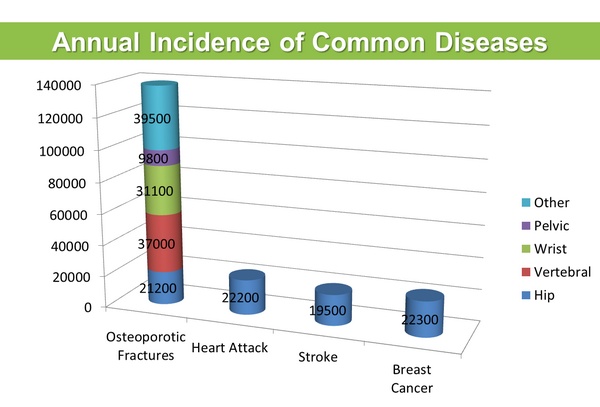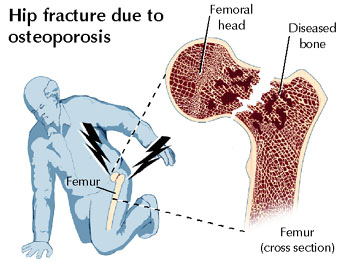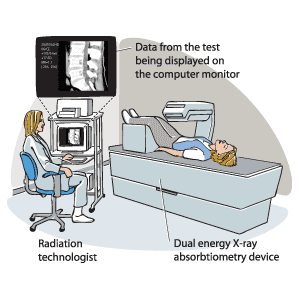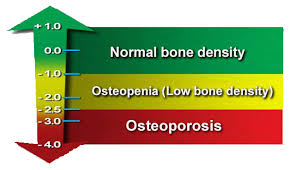Osteoporosis: The Silent Thief – Part 1
What is ‘Osteoporosis’?
Osteoporosis is a word derived from Greek language that literally means ‘porous bones’. In other words, it means deterioration of bone tissue, and low bone mass (low bone density). Because bone loss often happens without any signs or symptoms, it is often referred to as the ‘silent thief’.

The image above is showing you the bone density in a hip at the femur (thigh bone). As you can see, the image on the left has bone that is packed together far tighter than the bone on the right. The fact that there is more bone in healthy bone means it is stronger and more resilient to stress.
What does Osteoporosis mean to me?
Because with osteoporosis the bone density is decreased (aka porous bones), the bones are more fragile or brittle. And having these fragile bones means there is an increased risk of fracture (breaking a bone), especially to the bones of the spine, hip, wrist, and shoulder.
Fractures from Osteoporosis are more common than the incidence of heart attack, stroke, and breast cancer- combined! That is to say, at least 1 in 3 women and 1 in 5 men will suffer from an osteoporotic fracture in their lifetime!

Who does Osteoporosis affect?
Everyone! While it is slightly more common in women, especially those of caucasian or asian descent, it can and does affect everyone! Both men and women start to lose bone mass in their mid 30’s. As women approach menopause (~50 years of age), they begin to lose bone more rapidly than their male counterparts (at a rate of 2-3%/year)

How is Osteoporosis diagnosed?
First, a risk factor assessment by your physician will be completed. They are looking at a range of items, including age, gender, family history, medication/drug use, activity level, and menopausal status. This assessment won’t definitively diagnose Osteoporosis, it can simply suggest if someone is at a greater risk of having osteoporosis (and how much further testing is required).
Bone Mineral Density (BMD) Testing is the only way to definitively diagnose osteoporosis. This is also known as bone densitometry, or a DEXA Scan. The BMD test typically involves you laying on a table while a small X-Ray detector scans your spine and one (or both) hips. The test is safe and painless, and doesn’t require any injections. The amount of radiation you are exposed to is VERY small (about the same as flying on an airplane from Vancouver to Toronto).

Who should get a BMD Test?
While determining who should get a BMD test is largely based on the risk factor assessment, it is safe to say that everyone over age 65 should have their bone density tested. Some of these factors include a previous history of fragility fracture, high alcohol intake (> 3 drinks/day), tobacco smoker, and use of high risk medications for long periods of time such as oral corticosteroids. Your physician will be better able to assess your risk and determine if in fact you should have your BMD tested.
What do the BMD Test Results Mean?
You are given what is called a ‘T Score’. This is comparing your bone density to the typical bone density of a young, healthy adult. The ‘T Score’ is expressed as Standard Deviations (basically how far away you are from the norm). A T Score of -2.5 or less is given the diagnosis of ‘Osteoporosis’, while a T Score of -1 to -2.5 is given the diagnosis of ‘Osteopenia’. Osteopenia is lower bone density than anticipated, but bone loss isn’t yet so severe as to call it Osteoporosis.
In addition to being assigned a T Score, you will be given a 10-year estimate as to fracture risk based on your current bone density and other lifestyle factors.

What can I do to manage my Osteoporosis or prevent Osteoporosis in the Future?
Stay tuned for part 2 of this post, where I will focus on what can be done to manage Osteoporosis and what lifestyle factors you can address!
As always, contact your health care provider if you want more information, or if you think you are at risk for developing Osteoporosis.
Dr. Elaine Screaton (DC, BSc) is a Chiropractor currently practicing at Synergea Family Health Centre in Calgary, AB
References